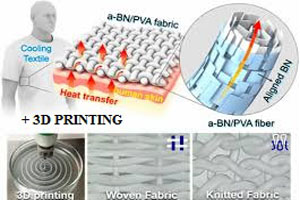

Technological advancements in textiles have given an impetus to efforts to aid in cooling have come from the realm of apparel and materials science. Previous efforts have seen the integration of cooling packs directly into clothing or the development of wicking fabrics, such as those used in sports apparel, but the development of the thermal cooling fabric could have wider applications in terms of types of apparel use.
But a recent research at the University of Maryland on a thermal regulation textile that might be the first step towards developing clothing that actually cools the wearer.
Studies undertaken with the textile demonstrate a thermal conductivity more than two times that of regular cotton fabrics.
The textile itself is created from a nano-fiber composite made up of Polyvinyl Alcohol (PVA) and boron nitride and then turned into fibers for weaving by a 3D printer. The woven fabric has a high level of thermal conductivity, meaning that it lets body heat pass right through it, thereby cooling its wearer.
Dr Liangbing Hu said that it is the first time that a highly thermally conductive textile is 3D printed with excellent mechanical strength and greatly enhanced thermal conductivity, which can cool the body significantly, especially for office settings for energy savings. They are carrying out more research to further improve the performance through materials design and also working on scalable demonstrations using 3D printing.
In addition to keeping the wearer cooler and therefore improving their overall satisfaction, something that has been repeatedly demonstrated to benefit corporate bottom lines, these textiles could conceivably lower the amount of conditioning that office air needs to receive in order to be comfortable for employees. This, in turn, reduces the amount of money that these businesses must spend on electricity and, thereby, the carbon footprint of those businesses.
Further research should hone the heat releasing aspects of the textile and allow experimentation with apparel design to work towards possibly bringing it to market.
These pioneering researchers, led by Liangbing Hu, have published the results of their studies in the latest issue of ACS Nano.
Circulose has entered a strategic partnership with Tangshan Sanyou Chemical Fiber, marking a major step toward the commercialization and scaling…
LebaTex has launched a new faux leather collection featuring over 100 unique colors and textures, including polyurethane, vinyl, and silicone…
Gabriela Hearst has introduced eco-friendly sneaker line, named "Ohio," made from 30% recycled materials, reflecting the brand’s commitment to sustainability.
Oysho, the sportswear and leisurewear brand, has collaborated with Fulgar to introduce a new eco-friendly activewear collection made with Q-Cycle…
Autoneum has developed E-Fiber flame shields for electric vehicles, which stand out for their high-temperature resistance, lightweight structure and durability.
McLaren has introduced a world-first innovation in supercar engineering, Automated Rapid Tape (ART) carbon fibre redefining performance while reducing waste.